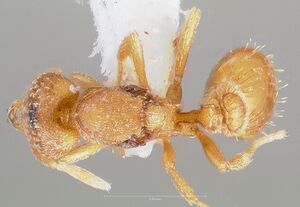Strumigenys alapa
| Strumigenys alapa | |
|---|---|

| |
| Scientific classification | |
| Kingdom: | Animalia |
| Phylum: | Arthropoda |
| Class: | Insecta |
| Order: | Hymenoptera |
| Family: | Formicidae |
| Subfamily: | Myrmicinae |
| Tribe: | Attini |
| Genus: | Strumigenys |
| Species: | S. alapa |
| Binomial name | |
| Strumigenys alapa Fisher, 2000 | |
Specimens have been collected from litter samples in a range of forest habitats.
Identification
Bolton (2000) - A member of the alapa complex in the Strumigenys arnoldi-group. S. alapa is distinguished from other species in the arnoldi-group by the following combination of characters.
1 Head and upper scrobe margin with broadly spatulate to spoon-shaped hairs.
2 Pronotal humeral hair stiff, remiform to thickly clavate and projecting laterally.
3 Alitrunk in profile almost flat; mesonotum in profile without a deep depression posteriorly before meeting the propodeum.
Keys including this Species
Distribution
Latitudinal Distribution Pattern
Latitudinal Range: -18.0264° to -23.65°.
| North Temperate |
North Subtropical |
Tropical | South Subtropical |
South Temperate |
- Source: AntMaps
Distribution based on Regional Taxon Lists
Malagasy Region: Madagascar (type locality).
Distribution based on AntMaps
Distribution based on AntWeb specimens
Check data from AntWeb
Countries Occupied
| Number of countries occupied by this species based on AntWiki Regional Taxon Lists. In general, fewer countries occupied indicates a narrower range, while more countries indicates a more widespread species. |

|
Estimated Abundance
| Relative abundance based on number of AntMaps records per species (this species within the purple bar). Fewer records (to the left) indicates a less abundant/encountered species while more records (to the right) indicates more abundant/encountered species. |

|
Biology
Castes
Queen
Images from AntWeb
   
| |
| Paratype of Strumigenys alapa. Queen (alate/dealate). Specimen code casent0005482. Photographer April Nobile, uploaded by California Academy of Sciences. | Owned by CAS, San Francisco, CA, USA. |
   
| |
| Queen (alate/dealate). Specimen code casent0004368. Photographer April Nobile, uploaded by California Academy of Sciences. | Owned by CAS, San Francisco, CA, USA. |
Nomenclature
The following information is derived from Barry Bolton's Online Catalogue of the Ants of the World.
- alapa. Strumigenys alapa Fisher, in Bolton, 2000: 629, fig. 383 (w.q.) MADAGASCAR.
Unless otherwise noted the text for the remainder of this section is reported from the publication that includes the original description.
Description
Worker
Holotype. TL 1.7, HL 0.44, HW 0.38, CI 85, ML 0.14, MI 31, SL 0.23, SI 62, PW 0.23, AL 0.44. Characters of alapa-complex. Mandible with a single preapical tooth. Dorsum of head posterior of frontal lobes and along upper scrobe margin with spoon-shaped hairs that are similar in shape to hairs on leading edge of scape. In full-face view, occipital angles without spoon-shaped hairs. Cephalic dorsum with a transverse row of 4 erect, short clavate hairs near occipital margin. Pronotal humeral hair present, stiffly erect and clavate. Mesonotum with a pair of short erect hairs, located at anterior margin. In profile, promesonotal dorsum very shallowly convex; propodeal dorsum shallowly convex anteriorly, sloping posteriorly to the declivity. Spongiform tissue well developed on declivity of propodeum, petiole and postpetiole. Propodeal teeth incorporated in the lamellae, the latter broad, more than half as broad as ventral lamella of petiole. Colour dull yellow to pale brown.
Paratypes. TL 1.7-1.9, HL 0.43-0.48, HW 0.36-0.39, CI 81-84, ML 0.13-0.15, MI 29-32, SL 0.23-0.26, SI 60-69, PW 0.21-0.24, AL 0.45-0.48 (4 measured). As holotype.
Type Material
Holotype worker, Madagascar: Provo Toliara, Beza-Mahafaly, 27 km. E Betioky, 23°38'S, 44°38'E, 135 m., 23.iv.1997, sifted litter (leaf mold, rotten wood), tropical dry forest #1476 (L. O.)-1 (B. L. Fisher) (Museum of Comparative Zoology).
Paratypes. 1 worker and 1 queen (dealate) with same data as holotype; 3 workers and 1 queen (dealate) with same data as holotype but coded (14)-1, (42)-1, (12)-1 (The Natural History Museum, South African Museum).
References
- Fisher, B.L. 2000. The Malagasy fauna of Strumigenys. Pp. 612-696 in: Bolton, B. 2000. The ant tribe Dacetini. Memoirs of the American Entomological Institute. 65:1-1028. (page 629, worker described)
References based on Global Ant Biodiversity Informatics
- Blaimer B. B., S. G. Brady, T. R. Schultz, and B. L. Fisher. 2015. Fucntional and phylogenetic approaches reveal the evolution of diversity in a hyper diverse biota. Ecography 38: 001-012.
- Bolton, B. 2000. The Ant Tribe Dacetini. Memoirs of the American Entomological Institute 65
- Fisher B. L. 2003. Formicidae, ants. Pp. 811-819 in: Goodman, S. M.; Benstead, J. P. (eds.) 2003. The natural history of Madagascar. Chicago: University of Chicago Press, xxi + 1709 pp.
- Ravelomanana A., and B. L. Fisher. 2013. Diversity of ants in burned and unburned grassland , and dry deciduous forest in the Beanka Reserve, Melaky Region, western Madagascar. Malagasy Nature 7: 171-183.

